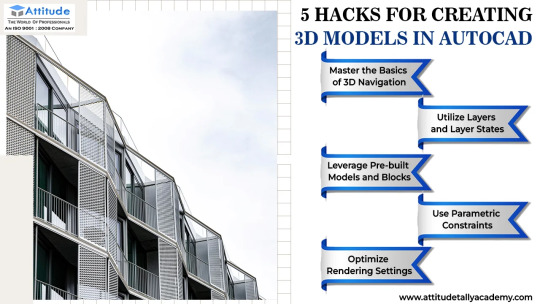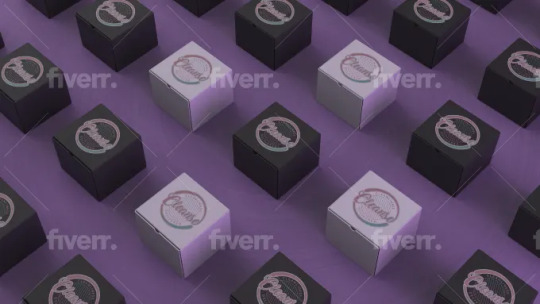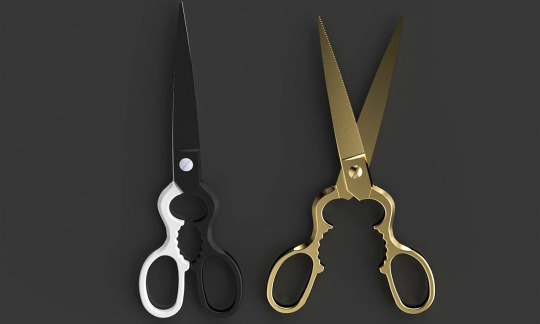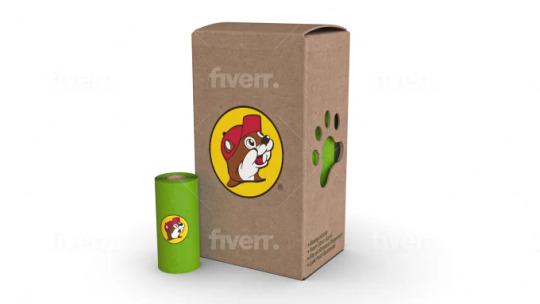#autocad tutorials
Explore tagged Tumblr posts
Text
5 Hacks for Creating 3D Models in AutoCAD

Introduction
Creating 3D models in AutoCAD can be a game-changer for your projects, allowing you to visualize designs in a more dynamic and detailed way. Whether you’re a beginner or a seasoned professional, these five hacks will help you enhance your AutoCAD 3D modeling skills and boost your productivity. Let’s dive into these AutoCAD 3D Modeling Hacks and make your modeling process more efficient and enjoyable! Read More........
#autocad training in uttam nagar#autocad classes in yamuna vihar#civil autocad training#autocad skills#autocad tutorials#interior designing training classes#interior designing classes#interior designing classes in uttam nagar#interior designing classes in yamuna vihar
0 notes
Text
Belajar AutoCAD 2D Denah Rumah Type 36 Plus Dengan MUDAH
youtube
#autocad #autocad2d #belajarautocad #autocadpemula
6 notes
·
View notes
Video
youtube
¡Aprende a usar las poderosas Cotas Anotativas en AutoCAD y ahorra tiemp...
0 notes
Text
youtube
AutoCAD 2007 Install x32 & x64 | Design Master Rokon Setup Guide
#autocad 2007 install#autocad#autocad 2007 installation#autocad 2007 x32#autocad 2007 x64#autocad install tutorial#autocad 2007 setup guide#design master rokon#design master rokon setup#autocad installation guide#how to install autocad 2007#design master rokon autocad#autocad 2007 installation windows#autocad setup tutorial#autocad 2007#civil engineering#autocad tutorial#youtube#Youtube
1 note
·
View note
Video
youtube
Solución para Escalera en 5 minutos que necesitabas en AutoCAD | BLOQUE ...
0 notes
Video
youtube
Complex Surface Modelling in Inventor || Surface Modelling in Inventor |...
#youtube#autodesk inventor drawing tutorial beginner autocad inventor 2022 tutorial autocad 3d mechanical drawing tutorial autodesk inventor 3d model
0 notes
Text
youtube
Brief Tutorial on the AutoCAD Basics
- general lineweights (plan examples)
- open new file
- template (CTB not STB)
- interface (classic vs new)
- right click customization
- units
- scale of drawing (actual size)
- sheets
- general commands (from EX 1)
- CTB file (on MAC import)
- print
LAYERS
- thickness vs per element
2 notes
·
View notes
Text
3d product renderings and mockups

It seems like you're looking for information or assistance with 3D product renderings and mockups. Creating 3D product renderings and mockups is a crucial step in the design and marketing process for various industries. Here's some information to help you get started:
1. Software for 3D Rendering:
Blender: A powerful and free open-source 3D creation suite.
Autodesk Maya: Widely used in the film and video game industry.
Cinema 4D: Known for its intuitive interface and powerful capabilities.
KeyShot: A standalone 3D rendering and animation application.
2. Creating 3D Models:
CAD Software (Computer-Aided Design): Use software like AutoCAD, SolidWorks, or Rhino to create accurate 3D models.
Sculpting Software: Tools like ZBrush or Blender's sculpting features are great for organic shapes.
3. Texturing and Materials:
Apply realistic textures and materials to your 3D model using UV mapping techniques.
Software like Substance Painter or Quixel Mixer can help create detailed and realistic materials.
4. Lighting:
Proper lighting is crucial for realistic renders. Experiment with different light setups to achieve the desired look.
Consider using High Dynamic Range Imaging (HDRI) for realistic environmental lighting.
5. Rendering:
Choose the appropriate rendering engine for your needs (Cycles in Blender, Arnold, V-Ray, etc.).
Adjust rendering settings such as resolution, quality, and output format.
6. Mockup Tools:
Adobe Dimension: Allows you to create realistic 3D mockups and product visualizations.
Placeit: An online platform that lets you create mockups with your designs on various products.
Mockup World: Offers a variety of free and premium mockups for different products.
7. Tutorials and Learning Resources:
Online platforms like Udemy, Coursera, and YouTube offer tutorials on 3D modeling, rendering, and mockup creation.
Join forums and communities like Blender Artists or Polycount for support and feedback.
8. Considerations for Product Mockups:
Understand the target audience and purpose of the mockup.
Pay attention to lighting, shadows, and reflections to make the mockup realistic.
Test the mockup on different backgrounds to ensure versatility.
9. Outsourcing:
If creating 3D models and renders is outside your expertise, consider outsourcing to professional 3D artists or agencies.
Remember to practice and experiment with different techniques to refine your skills. The field of 3D rendering is vast, and continuous learning is key to staying updated with the latest trends and technologies.




#shirts#shirt design#artist shirts#tees#tshirts#toby's beans#coffee cat#sundew farms#sunflower fox#sugarbritches#apple orchard#vintage logos#logo design#shop#merch#countrycore#farmcore#cottagecore#fashion#my art#horror#slashers#graphic design#the conjuring#the conjuring 3#the conjuring: the devil made me do it#scream#scream 1996#a nightmare on elm street#anoes
2 notes
·
View notes
Text
youtube
In this quick tip AutoCAD tutorial, we will learn how to recreate missing hatch boundaries.
#autocad#autocad tutorials#autocad hatch#autocad troubleshooting#autocad hatch boundary#autodesk#autodesk autocad#autocad tips#Youtube
0 notes
Text
How to Prepare for Site Engineer Jobs from College

Being a site engineer is a dream for most civil, mechanical, or electrical engineering students. Being a site engineer means being responsible for overseeing construction projects, resolving on-site issues & ensuring things go smoothly. But securing a great job after college is not a matter of chance; it is a matter of proper planning, skills & preparation during college life.
If you are still a student & concerned with your future as a site engineer, now is the best time to start preparing. After all, with the right steps & mindset, you can increase your chances of being well-employed in the profession right after graduation. This blog will guide you through site engineer job preparation for students in an easy way with simple tips & ideas you can start implementing right away.
Focus on Learning Practical Skills
Theory is essential, but site engineering is all about practical skills. Many students often focus only on books & classroom lectures, but actual on-site problems can be quite different. As a result, learn how to read site drawings, operate basic tools, understand measurements & become familiar with construction materials.
To improve your hands-on knowledge, make every effort to go to lab classes regularly, participate in workshops & take part in college assignments. Even if your college does not frequently offer site visits, you can ask your seniors or teachers for this. Remember, the more you observe & experience, the better your understanding will be.
Do Internships & On-Site Training
One of the best tips to become a site engineer after college is to do at least one or two internships during your college years. Internships will help you understand how actual construction sites work & provide you with hands-on experience. You can work under experienced engineers & get an idea of how to tackle timelines, labour, weather issues & actual materials.
Even a one-month on-site training during your semester break can teach you a lot. Companies also like students who have already worked in real-world environments, so internships can provide your resume with a big boost. If your college has campus internship tie-ups, don’t let it pass!
Learn Important Software Tools
A site engineer not only deals with cement & bricks, but they also deal with software. AutoCAD, MS Project, Revit & STAAD Pro are some of the most used tools for planning, designing & monitoring work progress. Being able to use them will set you apart from other candidates in an interview.
You don’t have to be a software guru, but being familiar with the basics of one or two of them is highly beneficial. You can do short online courses, view tutorials, or be part of college-hosted certification programs.
To read more, visit: https://bfitgroup.in/prepare-for-site-engineer-jobs-from-college/
0 notes
Text
AutoCAD 2D Lanjutan 12 Perintah Dasar Tingkatkan Skill!
youtube
0 notes
Video
youtube
¡Tips rápidos de AutoCAD! Hoy: Copiar, mover, rotar y escalar en el mism...
0 notes
Video
youtube
🔴 CÓMO CONVERTIR OBJETOS 3D A LÍNEAS EN AUTOCAD DE MANERA RÁPIDA Y FÁCIL...
0 notes
Video
youtube
Suspension System in Autodesk Inventor || Inventor Tutorials || Autodesk...
#youtube#autodesk inventor drawing tutorial beginner autocad inventor 2022 tutorial autocad 3d mechanical drawing tutorial autodesk inventor 3d model
0 notes
Text
0 notes